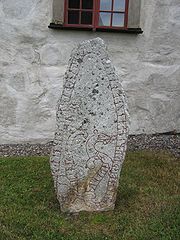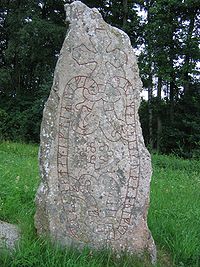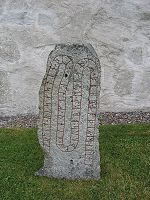
Ulf of Borresta
Encyclopedia



Runemaster
A runemaster or runecarver is a specialist in making runestones.Most early medieval Scandinavians were probably literate in runes, and most people probably carved messages on pieces of bone and wood. However, it was difficult to make runestones, and in order to master it one also needed to be a...
in eleventh century Uppland
Uppland
Uppland is a historical province or landskap on the eastern coast of Sweden, just north of Stockholm, the capital. It borders Södermanland, Västmanland and Gästrikland. It is also bounded by lake Mälaren and the Baltic sea...
, Sweden
Sweden
Sweden , officially the Kingdom of Sweden , is a Nordic country on the Scandinavian Peninsula in Northern Europe. Sweden borders with Norway and Finland and is connected to Denmark by a bridge-tunnel across the Öresund....
, but also a successful Viking
Viking
The term Viking is customarily used to refer to the Norse explorers, warriors, merchants, and pirates who raided, traded, explored and settled in wide areas of Europe, Asia and the North Atlantic islands from the late 8th to the mid-11th century.These Norsemen used their famed longships to...
who returned from England
England
England is a country that is part of the United Kingdom. It shares land borders with Scotland to the north and Wales to the west; the Irish Sea is to the north west, the Celtic Sea to the south west, with the North Sea to the east and the English Channel to the south separating it from continental...
three times with a share of the Danegeld
Danegeld
The Danegeld was a tax raised to pay tribute to the Viking raiders to save a land from being ravaged. It was called the geld or gafol in eleventh-century sources; the term Danegeld did not appear until the early twelfth century...
. He is named after his estate which in modern Swedish
Swedish language
Swedish is a North Germanic language, spoken by approximately 10 million people, predominantly in Sweden and parts of Finland, especially along its coast and on the Åland islands. It is largely mutually intelligible with Norwegian and Danish...
is called Borresta or Bårresta (Old Norse
Old Norse
Old Norse is a North Germanic language that was spoken by inhabitants of Scandinavia and inhabitants of their overseas settlements during the Viking Age, until about 1300....
: Báristaðir or BárastaðiR).
Ulf's clan
Ulf belonged to a clanNorse clans
The Scandinavian clan or ætt was a social group based on common descent or on the formal acceptance into the group at a þing.-History:...
in what is today the parish of Orkesta
Orkesta
Orkesta is a parish with 1103 inhabitants , located in Vallentuna Municipality, Stockholm County in Sweden. It is located at 59°36'0.00"N latitude, 18° 7'0.00"E longitude. Its altitude is at 21.95 meters ....
, and he was the paternal nephew and successor of a man named Ónæmr, a name which means "slow learner". Ónæmr is mentioned on several runestones, U 112, U 336 and probably U 328
Uppland Runic Inscription 328
The Uppland Runic Inscription 328 stands on a hill in a paddock at the farm Stora Lundby, which is about four kilometers west of Lindholmen, Stockholm County, Sweden, in the historic province of Uppland...
(which is an example of the Ringerike style.). The name of Guðlaug's father on U 328 is interpreted as Ónæmr, and Guðlaug had a son named Holmi who fell in Italy
Italy
Italy , officially the Italian Republic languages]] under the European Charter for Regional or Minority Languages. In each of these, Italy's official name is as follows:;;;;;;;;), is a unitary parliamentary republic in South-Central Europe. To the north it borders France, Switzerland, Austria and...
which is mentioned on the runestone U 133. Another cousin of Ulf named Ragnvaldr
Ragnvald Ingvarsson
Ragnvaldr was a captain of the Varangian Guard in the first half of the 11th century. He may appear on several runestones, some of which suggest that he was the son of an Ingvar connecting him to the Jarlabanke clan....
was the commander of the Varangian Guard
Varangian Guard
The Varangian Guard was an elite unit of the Byzantine Army in 10th to the 14th centuries, whose members served as personal bodyguards of the Byzantine Emperors....
in Constantinople
Constantinople
Constantinople was the capital of the Roman, Eastern Roman, Byzantine, Latin, and Ottoman Empires. Throughout most of the Middle Ages, Constantinople was Europe's largest and wealthiest city.-Names:...
and made the runestone U 112 in memory of himself and his mother, Ónæmr's daughter.
Runestones made by Ulf
Ulf made the runestone U 328 and also the runestone U 336 in memory of his uncle Ónæmr which today is raised at the church of OrkestaOrkesta
Orkesta is a parish with 1103 inhabitants , located in Vallentuna Municipality, Stockholm County in Sweden. It is located at 59°36'0.00"N latitude, 18° 7'0.00"E longitude. Its altitude is at 21.95 meters ....
. He also made the runestones U 160 and 161
Risbyle Runestones
The Risbyle Runestones are two runestones found near the western shore of Lake Vallentunasjön in Uppland, Sweden, dating from the Viking Age.-Descripiton:...
for his kinsmen-by-marriage in Skålhammar (Old Norse: Skulhamarr).
Runestones in Ulf's memory
There were seven runestones (runestone U 344 and runestone U 343) which were raised in Ulf's memory and they were raised together as a monument at Yttergärde. U 343 has disappeared but U 344 is presently raised at the church of OrkestaOrkesta
Orkesta is a parish with 1103 inhabitants , located in Vallentuna Municipality, Stockholm County in Sweden. It is located at 59°36'0.00"N latitude, 18° 7'0.00"E longitude. Its altitude is at 21.95 meters ....
.
The runestone U 344, in the style Pr3, was found in 1868, at Yttergärde, by Richard Dybeck
Richard Dybeck
Richard Dybeck was a Swedish jurist, antiquarian and lyricist, mainly remembered as the author of the lyrics to what is now the Swedish national anthem: Du gamla, Du fria....
. It can be dated to the first half of the 11th century because of its use of the ansuz rune
Ansuz rune
The a-rune , Younger Futhark was probably called *ansuz in Proto-Germanic, to which the Norse name Æsir is attributed.The shape of the rune is likely from Neo-Etruscan a , like Latin A ultimately from Phoenician aleph....
for the a and æ phomenes, and because of its lack of dotted runes.
This stone is notable because it commemorates that Ulf had taken three danegelds in England. The first one was with Skagul Toste
Skagul Toste
Skoglar Toste or Skoglar Tosti was a chieftain from the Swedish province of West Götaland. According to Snorri Sturluson, he was the father of Sigrid the Haughty. For some time he gave refuge to Harald Grenske, who later came back to woo Sigrid, only to be killed by her for his persistence...
in 991, the second one with Thorkel the High in 1012 and the last one with Canute the Great
Canute the Great
Cnut the Great , also known as Canute, was a king of Denmark, England, Norway and parts of Sweden. Though after the death of his heirs within a decade of his own and the Norman conquest of England in 1066, his legacy was largely lost to history, historian Norman F...
in 1018. Since there were many years between the danegelds, it is likely that Ulfr returned to Sweden after each danegeld to live as a wealthy magnate. It is a remarkable feat in itself to summarize Ulf's adventurous life in so few unsentimental words.
The runestone U 343 reports Ulf's death and it was raised in his memory by his sons Karsi and Karlbjörn.

